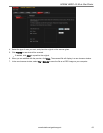
telephone service , 64, Connecting to a Digital Subscriber Line (DSL) , 65 or Connecting to an Internet or cable
telephone service (Voice-Over-Internet Protocol or VOIP), 65).
A shared phone line is one that has several devices connected to it, such as a phone and/or answering machine
as well as the printer. If you have a shared line, connect your printer in one of the following ways, based on the
devices you have connected to the same phone line.
If you share the line with an answering machine or telephone:
1. Connect one end of the phone cord that came with the printer to the LINE IN phone port on the back of the
printer.
2. Connect the other end of the phone cord to either a wall phone jack or a DSL filter, depending on the type
of telephone service you use.
3. Connect one end of the phone cord for your answering machine to the EXT OUT phone port on the back of
the printer.
4. Connect the other end of the phone cord to the answering machine or telephone.
: If you have an answering machine, set the number of rings to answer on the printer to a
higher number
than the rings to answer for the answering machine (see Rings to Answer
in the table under Selecting fax settings, 67).
If you have an answering service:
If you have an answering service that uses a computerised system for recording messages remotely for the
same phone line that you use for your all-in-one printer, then you can set up a distinctive ring to receive faxes
automatically (see Distinctive Ring in the table under Selecting fax settings, 67).
If you do not set up a distinctive ring, you can still receive faxes manually (see Receiving a fax manually ,
74).
Entering fax sender information
Fax sender information appears in the header of any fax that you send from your all-in-one printer. Typically this is
your name or your business name and your fax number.
: If you do not enter fax sender information, the header on faxes that you send will be blank.
To enter fax sender information:
Faxing
66 www.kodak.com/go/aiosupport


















